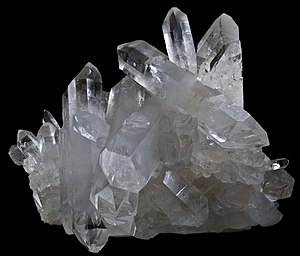Wikijunior:The Elements/Silicon


What does it look, feel, taste, or smell like?
[edit | edit source]
Silicon is a dark grey and metallic-looking solid. However, silicon is not a metal (or even a non-metal); it comes under a special category of elements called as metalloids which are those which have some properties of both metals and non-metals (between metals and non-metals).
How was it discovered?
[edit | edit source]Silicon was first identified by Antoine Lavoisier in 1787. It was then discovered by Jons Jacob Berzelius in Stockholm, Sweden in 1823.
Where did its name come from?
[edit | edit source]Silicon gets its name from silicis, which is Latin for flint.
Did You Know?
- Silicon is the second-most abundant element in the Earth's crust, behind only oxygen.
Where is it found?
[edit | edit source]Silicon is present in the sun and meteorites. Silicon makes up one quarter of the earth's crust. It is the second most abundant element on Earth, behind only oxygen. Silicon is not found free in nature, but occurs chiefly as silicon dioxide and as silicates. Sand, quartz, rock crystal, amethyst, agate, flint, jasper, and opal are some of the forms in which the dioxide appears. Granite, feldspar, clay, and mica are some of the silicate minerals.
What are its uses?
[edit | edit source]
Silicon is one of the most useful elements. In the form of sand and clay it is used to make concrete and brick. Silicates are used in making enamels, and pottery. Silica, as sand, is the principal ingredient of glass. Glass can be made into bottles, windows, lenses, and thousands of other objects.
Silicon can be used in transistors, solar cells, microprocessors and other electronic devices. It is an important ingredient in steel. Silicon carbide is used as an abrasive, and is used to coat some sandpapers
Is it dangerous?
[edit | edit source]No, silicon is not generally dangerous, but miners and stonecutters can develop a serious lung disease known as silicosis if they breathe in too much silicate dust, because the sharp edges of the silicate particles tear the alveoli (parts used to absorb oxygen from the air) and cause damage to the lungs.